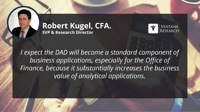The last decade has seen exponential growth amongst subscription-based business models. Pioneered in the B2C market with cloud-based SaaS offerings, the last decade has seen exponential growth in the share of the economy that is now subscription based. Increasingly, this modern business model is permeating throughout more traditional style industries and companies. But regardless of whether a company is natively subscription based, or is transitioning, maintaining this growth requires...
Read More
Topics:
Sales,
Customer Experience,
Office of Finance,
Voice of the Customer,
embedded analytics,
Analytics,
Business Intelligence,
Collaboration,
Internet of Things,
Contact Center,
Product Information Management,
Price and Revenue Management,
Digital Commerce,
Enterprise Resource Planning,
ERP and Continuous Accounting,
natural language processing,
robotic finance,
revenue and lease accounting,
Subscription Management,
agent management,
intelligent sales,
sales enablement,
AI & Machine Learning
An important recent development in software designed for the Office of Finance is the addition of what we’re calling a data aggregation device (DAD) for analytical applications. A DAD automates the collection of data from disparate sources using, for example, application programming interfaces (APIs) and robotic process automation (RPA). With a DAD, users of the analytical application have immediate access to a much broader data set; one that incorporates operational as well as financial data...
Read More
Topics:
Office of Finance,
Analytics,
Business Intelligence,
Data,
Financial Performance Management,
Price and Revenue Management,
robotic finance,
Predictive Planning,
AI & Machine Learning
In this Analyst Perspective from Robert Kugel, learn how FP&A can redefine its mission to achieve the long-stated goal of making it more of a strategic partner with the rest of the organization. This means fully adopting integrated business planning, a high participation, collaborative, action-oriented approach to planning and budgeting built on frequent, short planning sprints. Short planning cycles enable companies to achieve greater agility in responding to market or competitive changes, and...
Read More
Topics:
FP&A,
Office of Finance,
Budgeting,
Business Planning,
CFO,
financial planning,
forecasting
Subscription-based business models have seen exponential growth over the last decade. The growth of this recurring revenue business model, where a subscriber commits to repeatedly pay for a good or device for a fixed or indefinite timeline, has been caused by the shift from the one-time selling of physical products to selling digital services on a subscription basis. The first phase of this transformation was led by “digitally native” organizations, typically B2C, that have only ever offered...
Read More
Topics:
Sales,
Customer Experience,
Office of Finance,
Voice of the Customer,
embedded analytics,
Analytics,
Business Intelligence,
Collaboration,
Internet of Things,
Contact Center,
Product Information Management,
Price and Revenue Management,
Digital Commerce,
Enterprise Resource Planning,
ERP and Continuous Accounting,
natural language processing,
robotic finance,
revenue and lease accounting,
Subscription Management,
agent management,
intelligent sales,
sales enablement,
AI & Machine Learning
This analyst perspective (presentation) covers how Compensation Management, related enabling technologies and data strategies continue to evolve, particularly in the context of prominent business issues facing all organizations today.
{% video_player "embed_player" overrideable=False, type='scriptV4', hide_playlist=True, viral_sharing=False, embed_button=False, autoplay=False, hidden_controls=False, loop=False, muted=False, full_width=False, width='1440', height='810', player_id='34510456443',...
Read More
Topics:
HCM,
Compensation,
HR,
Talent Management,
TCM,
HR Tech,
HR technology,
Total Compensation Management,
HCM Systems,
employee experience,
People Analytics














